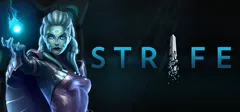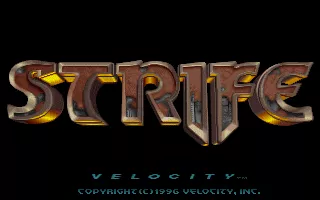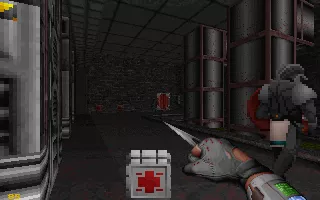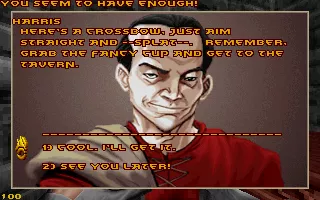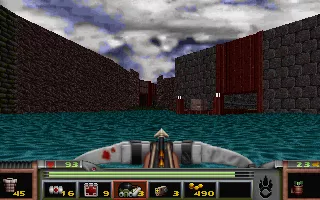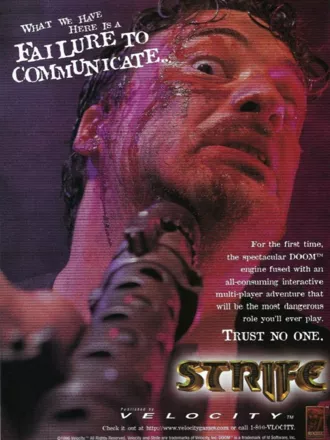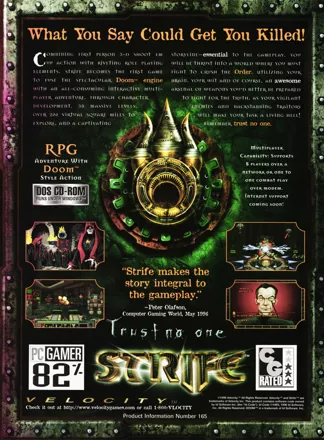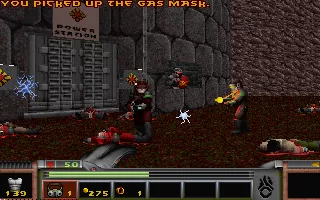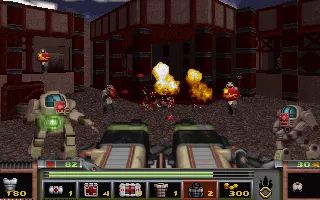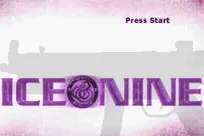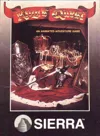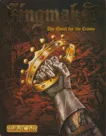Strife
Description official descriptions
In the distant future, the Earth is ruled by a group of people who call themselves "The Order". Many disasters have plagued the planet, and after many wars, misery, and death, the Order controls people's lives and deprives them of their freedom. A rebel organization has been formed, seeking to overthrow the Order and whoever else might be behind their rise to power. Somewhere in the depths of a ruined Town Hall, a group of people who oppose the Order's regime welcome a lone wanderer to become the one who will free the Earth from terror.
Strife is a plot-driven first-person shooter that uses the Doom engine. Rather than taking the player through a linear series of levels, the game offers a continuous world with free-roaming elements and a central "hub" (the town), which the player can visit between missions and explore. Although there are no true role-playing elements in the game, it has several features rarely seen in contemporary FPSs: there are "friendly" areas where there are no enemies but people to talk to, stores where new equipment can be bought, and taverns where the latest gossip is told. The player can also purchase upgrades that permanently increase the player character's health bar.
The game has a branching storyline with a few paths that lead to three different endings. These paths are determined by a decision the player makes during the course of the plot.
Groups +
Screenshots
Promos
Videos
Add Trailer or Gameplay Video +1 point
See any errors or missing info for this game?
You can submit a correction, contribute trivia, add to a game group, add a related site or alternate title.
Credits (DOS version)
66 People · View all
| Executive Producer | |
| Producers | |
| Designer | |
| Level Designers | |
| Writers | |
| Programmers | |
| 3D Engine Licensed from |
|
| Lead Artists | |
| Spin Doctor | |
| Artists | |
| Sound Effects | |
| Music | |
| [ full credits ] | |
Reviews
Critics
Average score: 68% (based on 21 ratings)
Players
Average score: 3.8 out of 5 (based on 58 ratings with 7 reviews)
The Good
This game was excellent. It took many of the Doom great features and used them to give a step further in gaming.
Now is when you can say "At least a FPS with a plot!!".
It wasn't just shooting everything that move. Even more, if you do it, you will get frustrated soon. Sometimes you'll have to talk with characters. Sometimes you will find allies or friends.
And, in a certain part of the story, you will have to choose to fight in one side or another.
What else could you ask?
The Bad
First of all, the graphics weren't too innovative by the time it was released.
Second, and most important... IT CAME TOO LATE!! Why?? When people were moving towards new game technologies, like Quake and other polygon based engines, Strife went into the light, using a technology from two years before.
It was a pity, because the game couldn't enjoy the recognition that it deserved.
The Bottom Line
Late delivering for a very good game.
DOS · by Emepol (212) · 2004
A truely innovative game which never caught on due to a somewhat outdated engine
The Good
Because it had an actual plot, this was the second FPS (the first being Dark Forces) that I ever had the patience to play from beginning to end. The programmers really did some amazing things with the ol' Doom engine.
For one thing, instead of linear levels the game used a hub system like Hexen where you could go back and forth between several different interconnected areas. Also instead of mission briefings your objectives were relayed to you in-game either by people you talked to or by your everpresent partner "Blackbird" on the radio. This gave the game a smooth transition and seamlessness I hadn't seen since until Half-Life came along.
Also, instead of a dead world populated only by monsters trying to kill you, Strife had various "friendly" areas such as two towns and two rebel bases where you could just wander around and talk to people or buy stuff. Even some of the "action" levels started out friendly and you could even have conversations with the guards (until you started shooting or entered a restricted area, at which point they'd start trying to kill you). Also, there was a great deal of variety to the levels (ranging from occupied town squares to old ruins) instead of the usual endless similar corridors.
When you talked to a major character, you got a close-up screen with comic art and speech. The comic art of the various characters was extremely well drawn, and the speech was pretty good as well. Your partner, Blackbird, also had various funny or oddball things to say over the radio about the various situations you found yourself in.
The action itself was pretty much standard Doom fare, with enemies who weren't too bright but who came at you in ridicuously large numbers. The enemies themselves ranged from the standard gun-toting guards to a variety of cool-looking battle robots. In terms of weaponry there were a few innovations, such as incindery grenades and a flamethrower you could use to sadistically burn your enemies alive, and a crossbow with poison arrows you could use to kill guards without setting off the alarm. There was even an item you could use to teleport friendly rebel soldiers to your location to fight for you (albeit not particularly well).
Also helping to set this game apart were the various set pieces in it. For example, at several points in the game you could sneak past hordes of guards with a fake ID or by pretending to be the janitor. One particularly fun level had you storming an enemy castle, and fighting alongside you was a small army of rebels engaging the enemie's forces in a large scale battle royale which was a real change from the typical one-man-against-the-world FPS scenario. In a similar scenario a single boss-character would show up in the middle of the rebel base and would wind up slaughtering them left and right if you didn't intervene. Finally, towards the ending of the game you were given a choice of two different "paths" which would lead you to two seperate endings. The good ending was your typical save-the-world-get-the-girl scenario, and was pretty tough since you had to go through several extra levels. Despite the grim outcome, I found the bad ending to be most interesting because of the surprise (and boy was it a surprise) identity of the final enemy.
The Bad
Well, the Doom engine was a bit dated at the time (I believe Quake was just coming out) but the programmers made enough tweaks to it (such as jumping/ducking, more "true life" textures, and a hub-based level system) so that it seemed fresh. I also think it didn't have support for mouse aiming, but when I played the game I hadn't heard of mouse aiming anyway so it didn't really make a difference to me.
Though this probably doesn't apply anymore, when I got the game it really cheesed me that it took a whopping 70 megabytes of hard disk space, and you had to install the full game and couldn't play it from the CD. I know that nowadays you could toss 70 megs out the window and never miss it, but back then I only had 30 megs free on my hard disk (which was all I ever needed for any of the other games I owned) and had to do some seriously weird stuff with my HD to get this game to work. But I think it was worth it. The game also didn't allow you to have multiple save slots for a single game, but a small patch (or creative copy/pasting) fixed this oversight.
My only real complaint was that the very last section of the game (the Order Factory) was pretty much just five levels of repetitive shooting and button-hunting, with none of the interactivity, creativity or atmosphere that made the rest of the game so compelling. However things did pick up when you reached the end of the Factory and got to the endgame.
The Bottom Line
After Half-Life's example, most modern first person shooters contain many of the elements which made this game so interesting. However, for it's time Strife was a very different and very enjoyable FPS experience.
DOS · by Alan Chan (3610) · 2000
The Good
Strife was the first game in memory to effectively combine the first person shooter and role-playing genres. It also included elements that were portentous of the "sneak" genre, as made popular by games like Thief and Metal Gear Solid. What set Strife apart from other games of the time, including the more technically-sophisticated Quake, was that it wasn't all about brazen blasting. There are of course times where the necessary course of action is to kill everything in your path, but there are other times where that mentality spells your imminent demise.
The weapon selection is quirky and unique. We're not talking pistols and shotguns anymore -- we've got unique energy weapons, a poisonous crossbow (which will prove to be your best friend in the first half of the game), and arson grenades.
Subtler elements include NPC interaction, in which you must choose your words wisely, multiple story paths, a helpful companion (albeit via walkie-talkie), the ability and necessity to be stealthy, a reasonably deep plot, and an open-level structure that would later appear in similar form in Half-Life.
The Bad
Strife was developed by small-potatoes studio Velocity, and as such wasn't afforded the budget it deserved. They licensed the archaic Doom engine in the Quake-era, which meant that the graphics even for the time didn't cut it. Even Doom and subsequent spin-offs Heretic and Hexen utilized the engine more stylistically than Strife -- the textures are overly-bright and amateurish, and the level design is at times very blocky. All the NPCs mostly look exactly the same, save color variation. The consequences of even the smallest slip-ups can sometimes have unfairly harsh consequences (the troops swarm in if you accidentally trip an alarm)
The Bottom Line
The primitive graphics are easy to overcome when you consider the sheer fun and depth of the gameplay. This is a precursor to what would become staple to the genre (story, character interaction, objective-based gameplay, stealth, etc.), but Strife did it first, and it did it right. If you can get your hands on a copy of this and a decent source-port, you'll find hours of classic entertainment. A truly underrated classic that never got the spotlight it deserved.
DOS · by jTrippy (58) · 2007
Trivia
Code
The source code of the game has unfortunately been lost; attempts to reverse engineer the code were made by the fans. The game can currently be played more or less faithfully with various source ports, such as ZDoom or Chocolate Strife (a port which uses code directly disassembled from the game executable itself).
Development history
Strife was originally in development by Cygnus Studios, the creators of Raptor: Call of the Shadows, and id Software was supposed to publish the game. However, game designer Jim Molinets left Cygnus and joined Rogue Entertainment, thus carrying his game design over with him. Cygnus and id no longer had anything to do with Strife at that point. Rich Fleider and Tim Neveu from Cygnus also joined the Rogue team as well to work on Strife. Shortly afterwards, Cygnus Studios was renamed to Mountain King Studios, and Mountain King hired new staff to work on their next project, Demonstar.
Extras
The CD-ROM package includes the "town map" on one side and the "field guide" on the other side of a sheet. The field guide illustrates the different enemies, weapons, ammo, armor, medical supplies, cold hard cash, and miscellaneous items encountered during the game.
Game engine
Strife was the Doom engine's last gasps for air. Not counting Chex Quest (which was only distributed in cereal boxes), it would be the final commercial standalone game to use id's engine.
Marketing
- Ads in US PC gaming magazines displayed review scores for the game-- 82% from PC Gamer, and 3/5 from Computer Gaming World. These are respectable but less-than-fantastic scores, so seems a bit odd that Velocity would choose to display these so prominently.
- Strife (at least in the UK) had a controversial advertising campaign. The ad took the form of a recipe:
*Strife
(for 8 people)
Ingredients: 1 brain (medium), 1 pair of balls (large)
Blend until smooth.
Sip during game play.*
The main part of the ad was a huge photo - The surface of a kitchen table with a few nice-looking herbs scattered around and, right in the middle, what looked like a big, wet, recently removed human brain and a large pair of...of...ah...hmm... Needless to say, there were lots of complaints and many magazines either refused to run the ad or plastered huge black boxes over the entire thing.
Patches
One of the things that people really complained about when Strife was released, was that it only had one save slot. Rogue fixed it in the version 1.3 patch, allowing you to have multiple save slots.
Rarity
The publisher Velocity closed down shortly after Strife was released and it is unclear who has held the rights to the game ever since, which is one of the reasons for its rarity.
Information also contributed by hydra9, Matt Dabrowski, NeoMoose, Roger Wilco, Spartan_234, Timo Takalo
Analytics
Upgrade to MobyPro to view research rankings!
Related Sites +
-
Crapshoot
A humorous review on PC Gamer -
Strife - Wikipedia
More history about this game -
Strife FAQs
GameFaqs FAQ and Walkthroughs
Identifiers +
Contribute
Are you familiar with this game? Help document and preserve this entry in video game history! If your contribution is approved, you will earn points and be credited as a contributor.
Contributors to this Entry
Game added by Derrick 'Knight' Steele.
Additional contributors: Shadowcat, Unicorn Lynx, Jeanne, Dae, Alaka, Havoc Crow, oct, Patrick Bregger.
Game added March 5, 2000. Last modified January 23, 2024.


